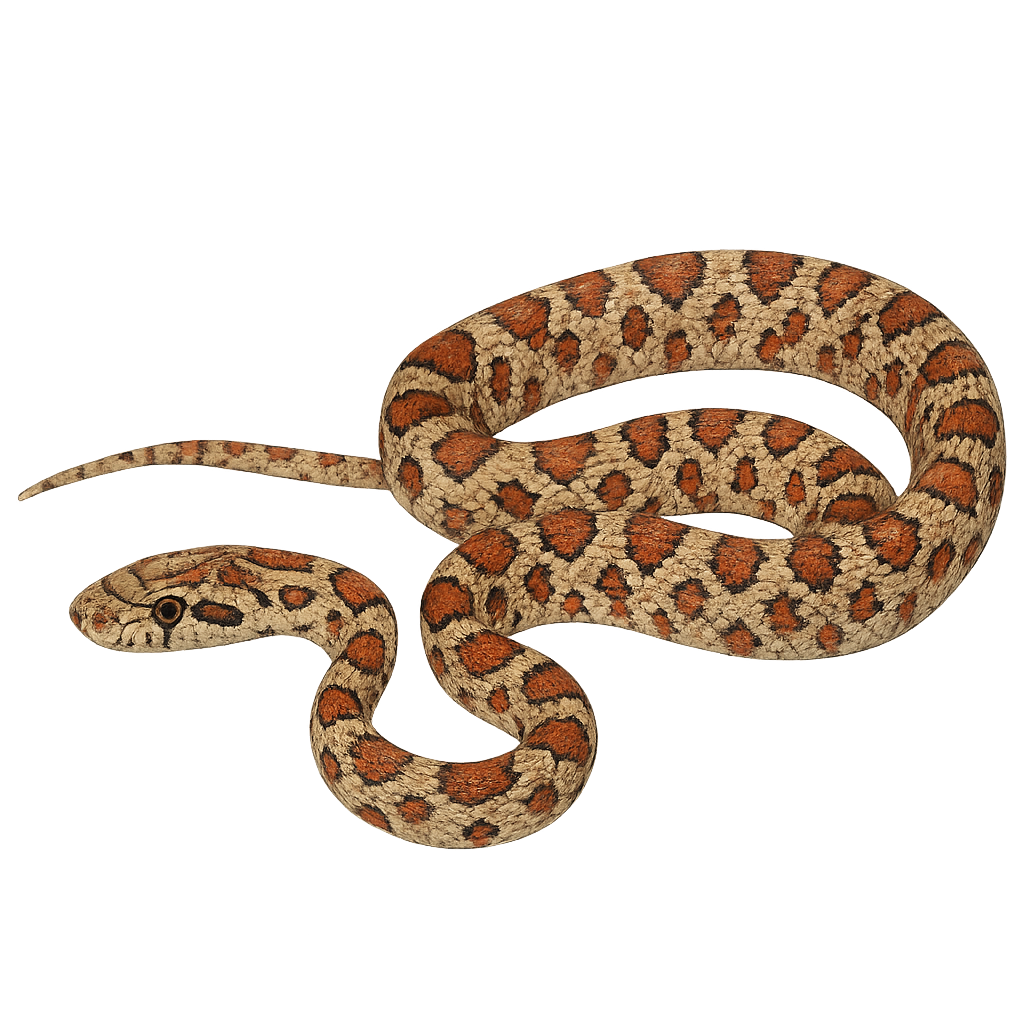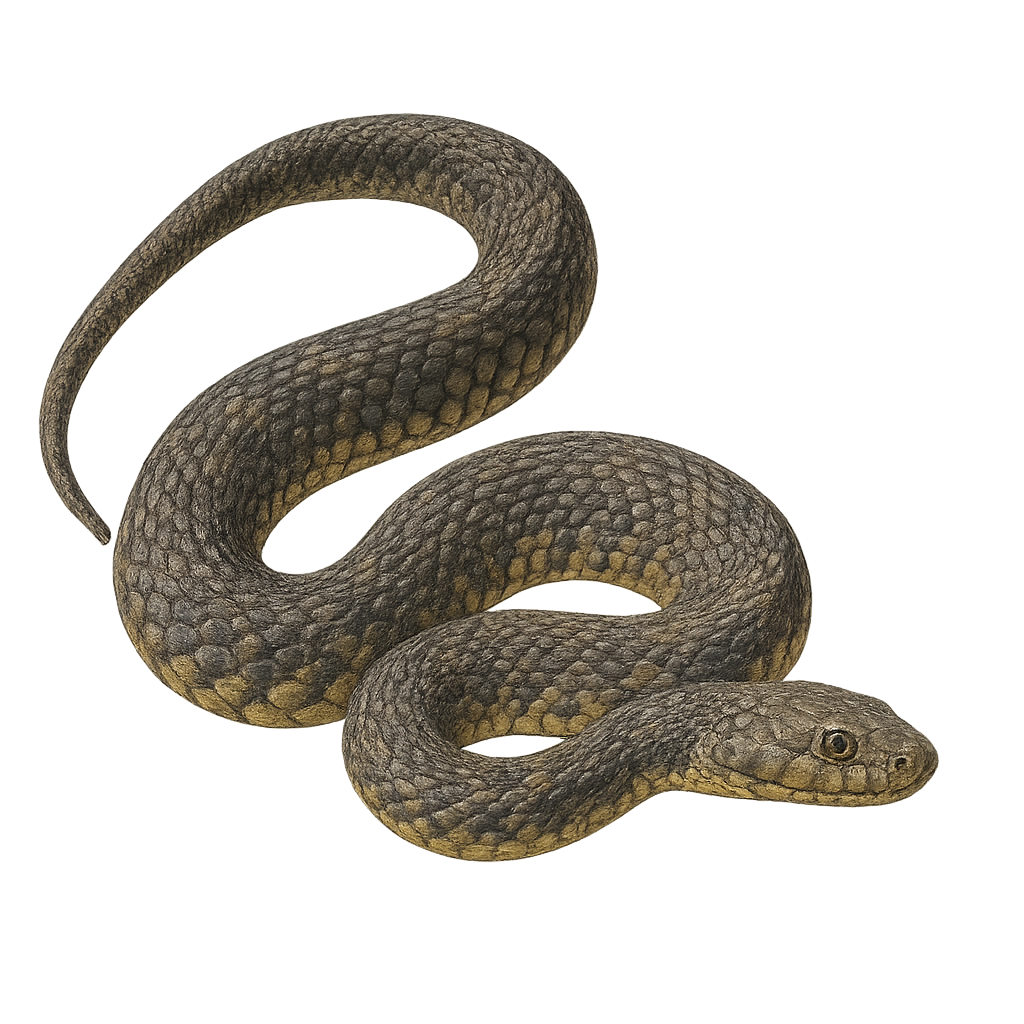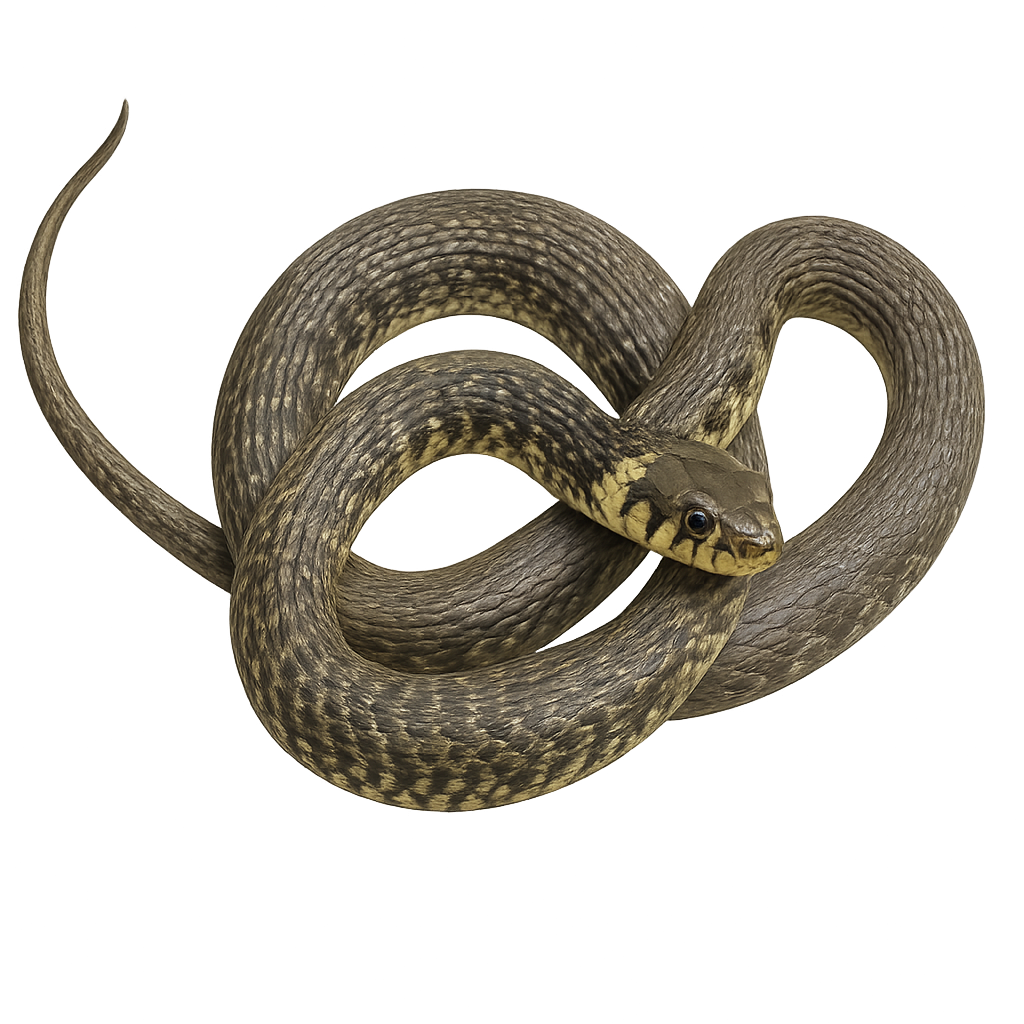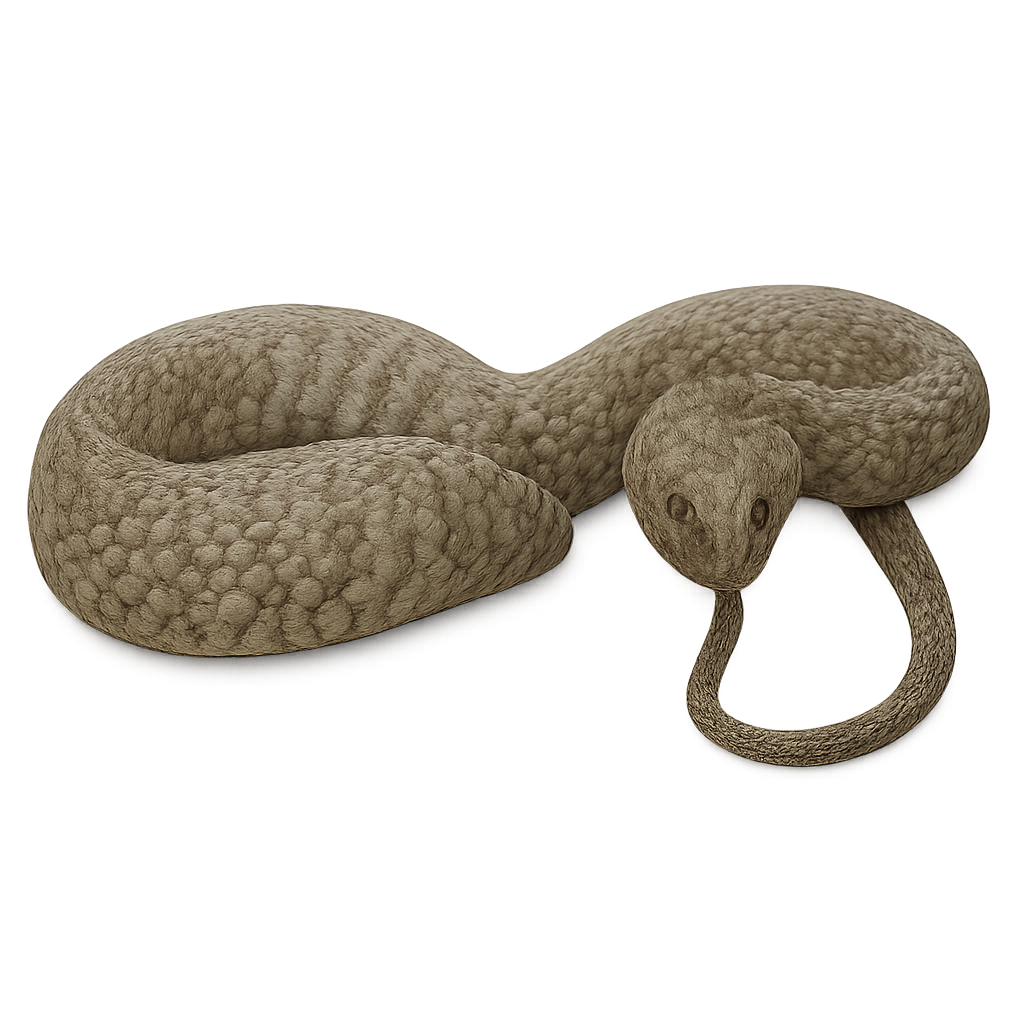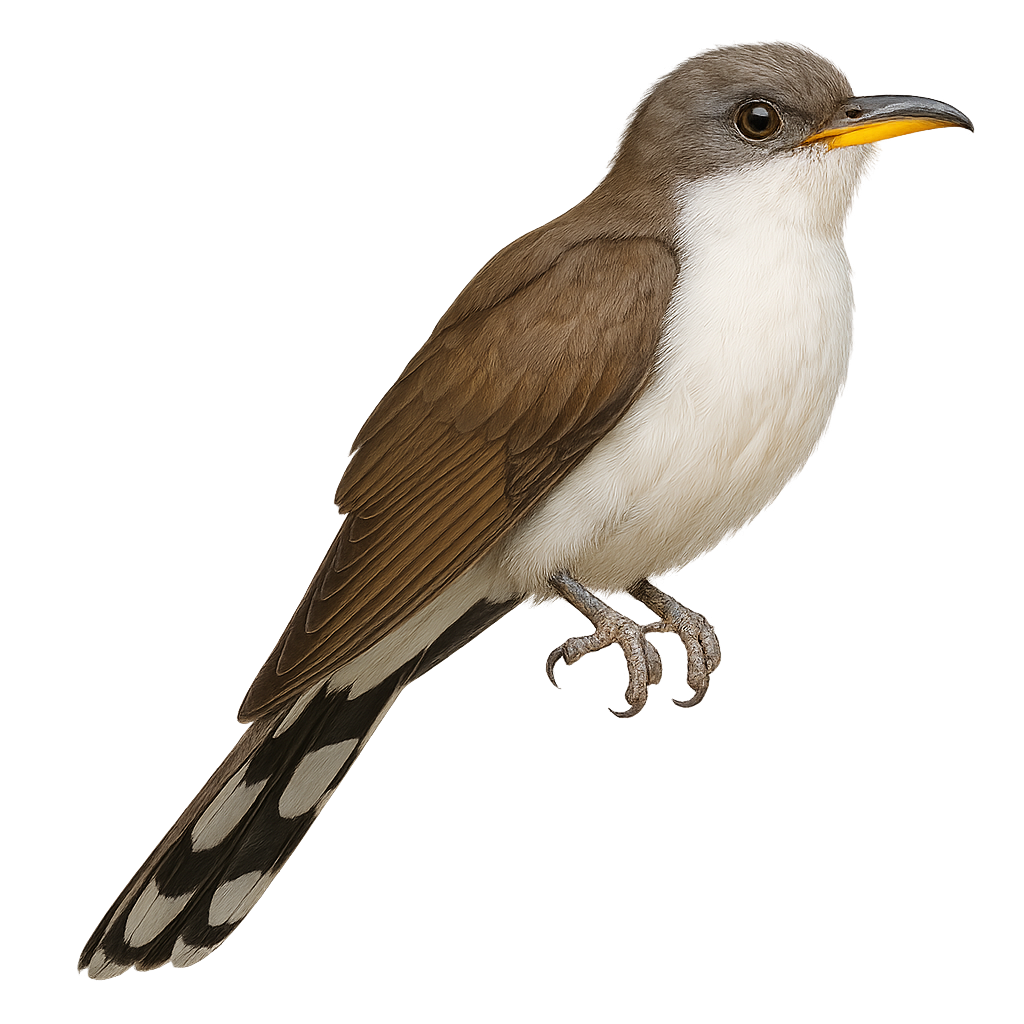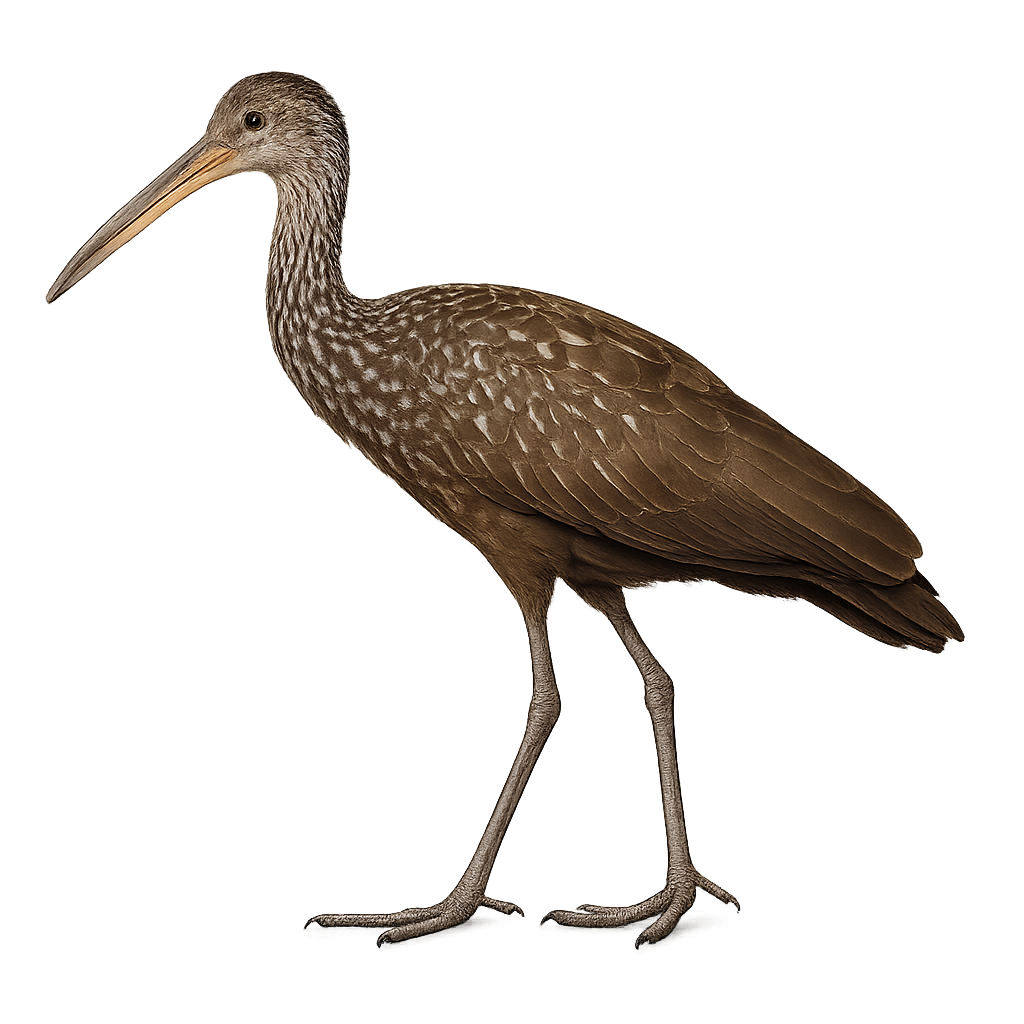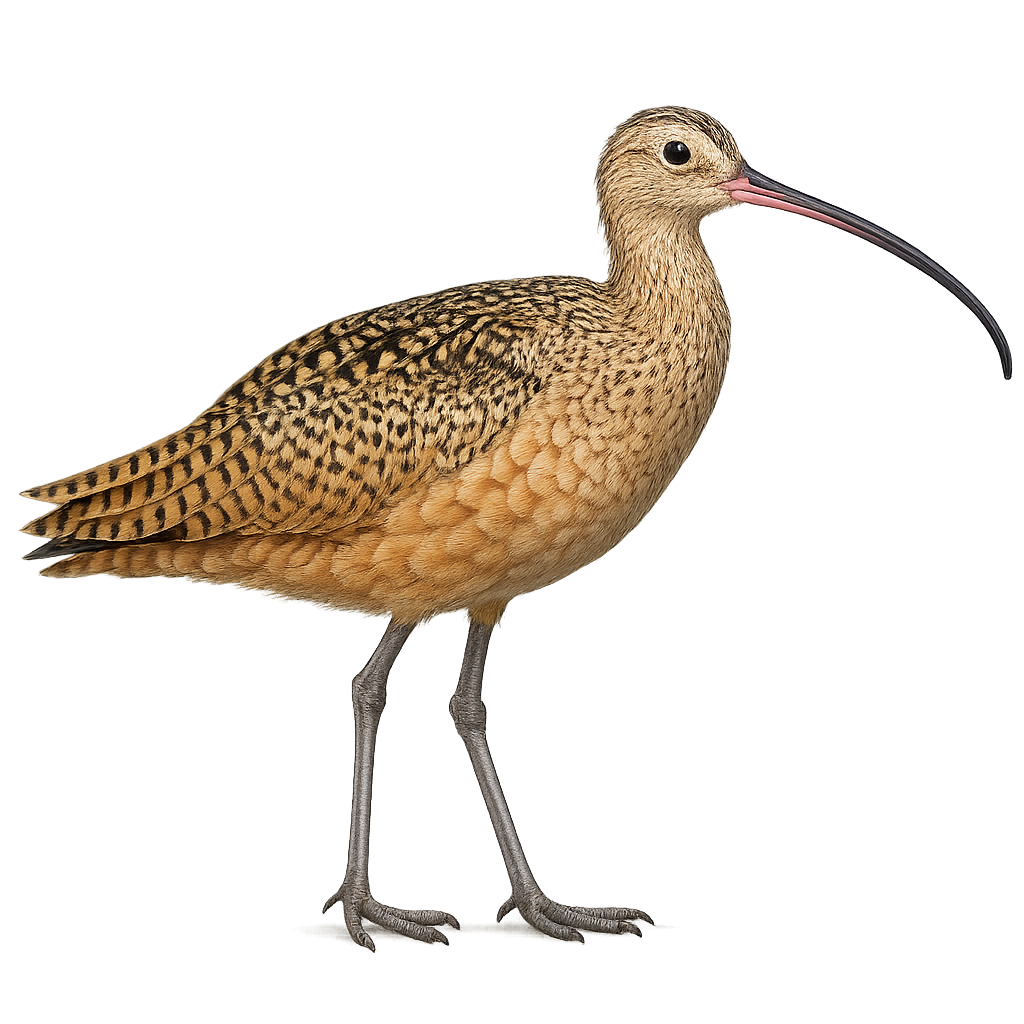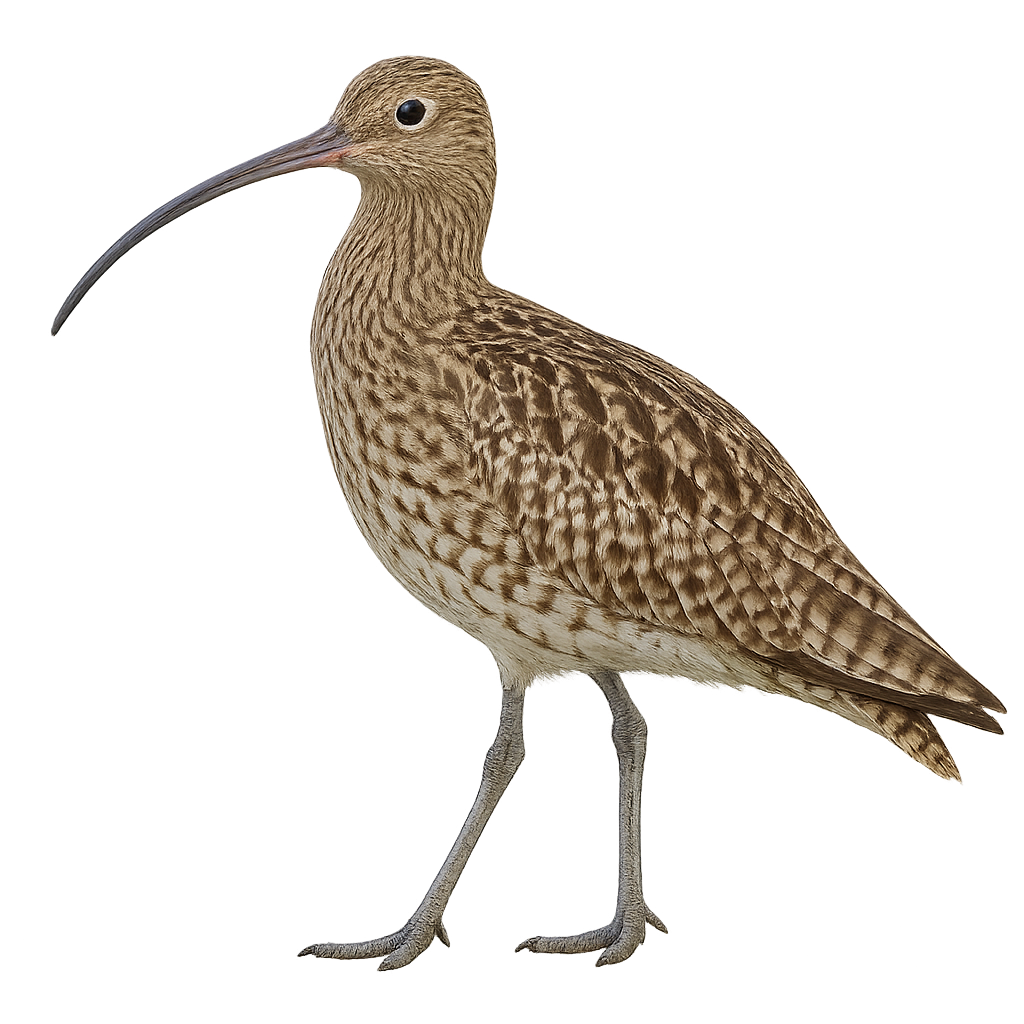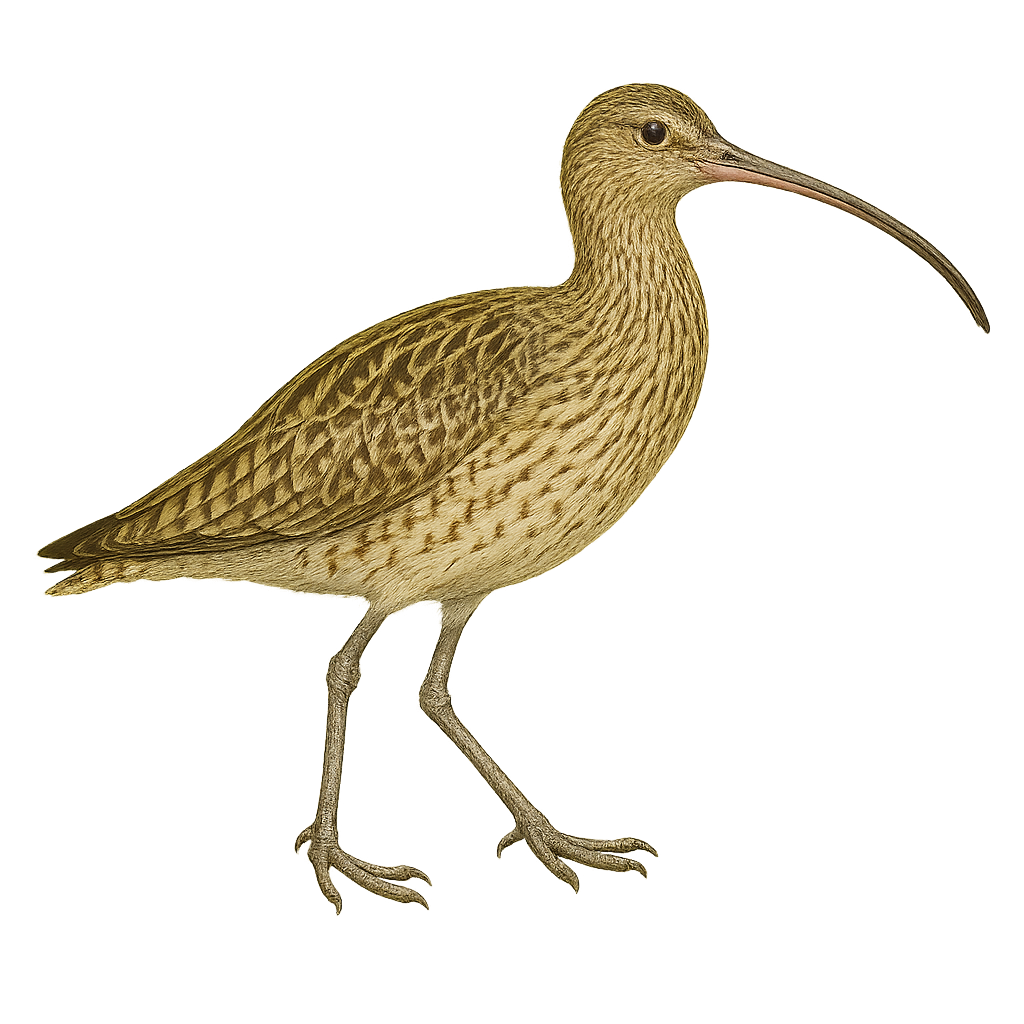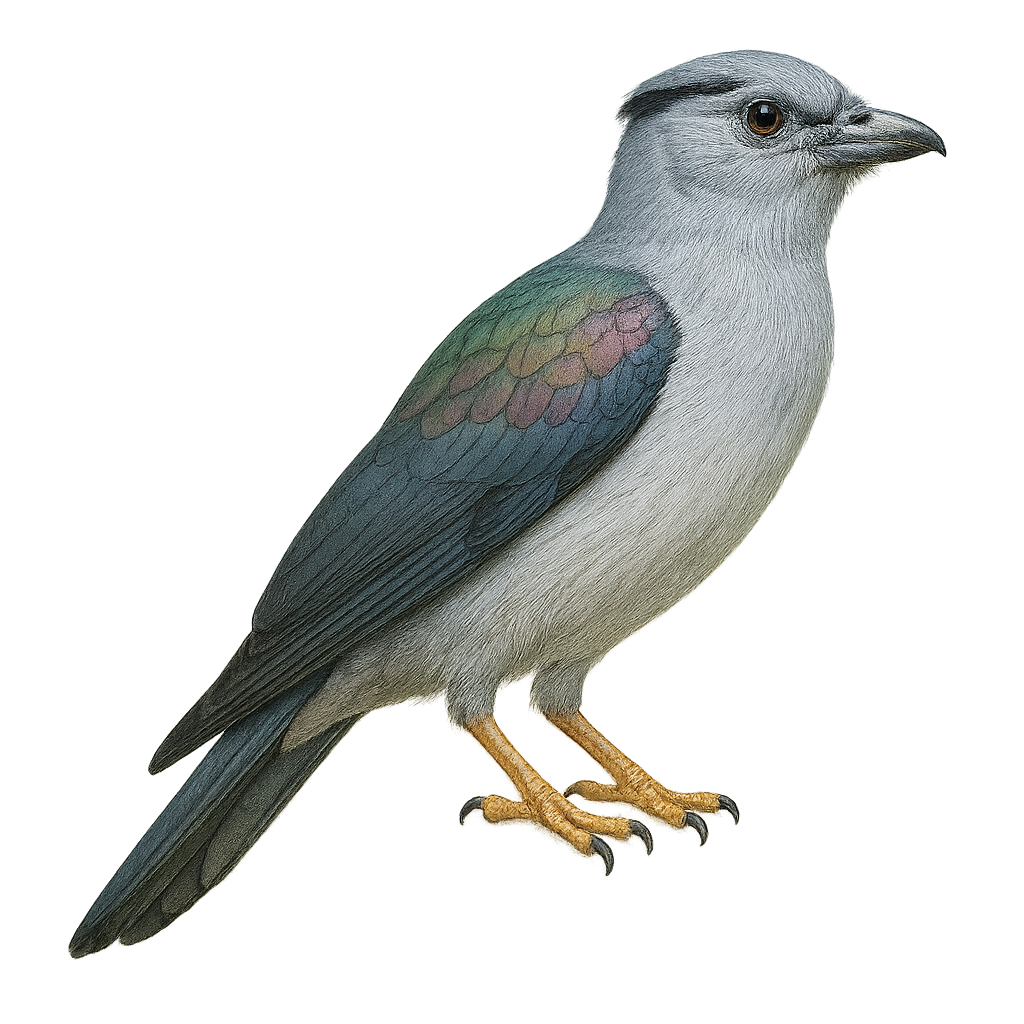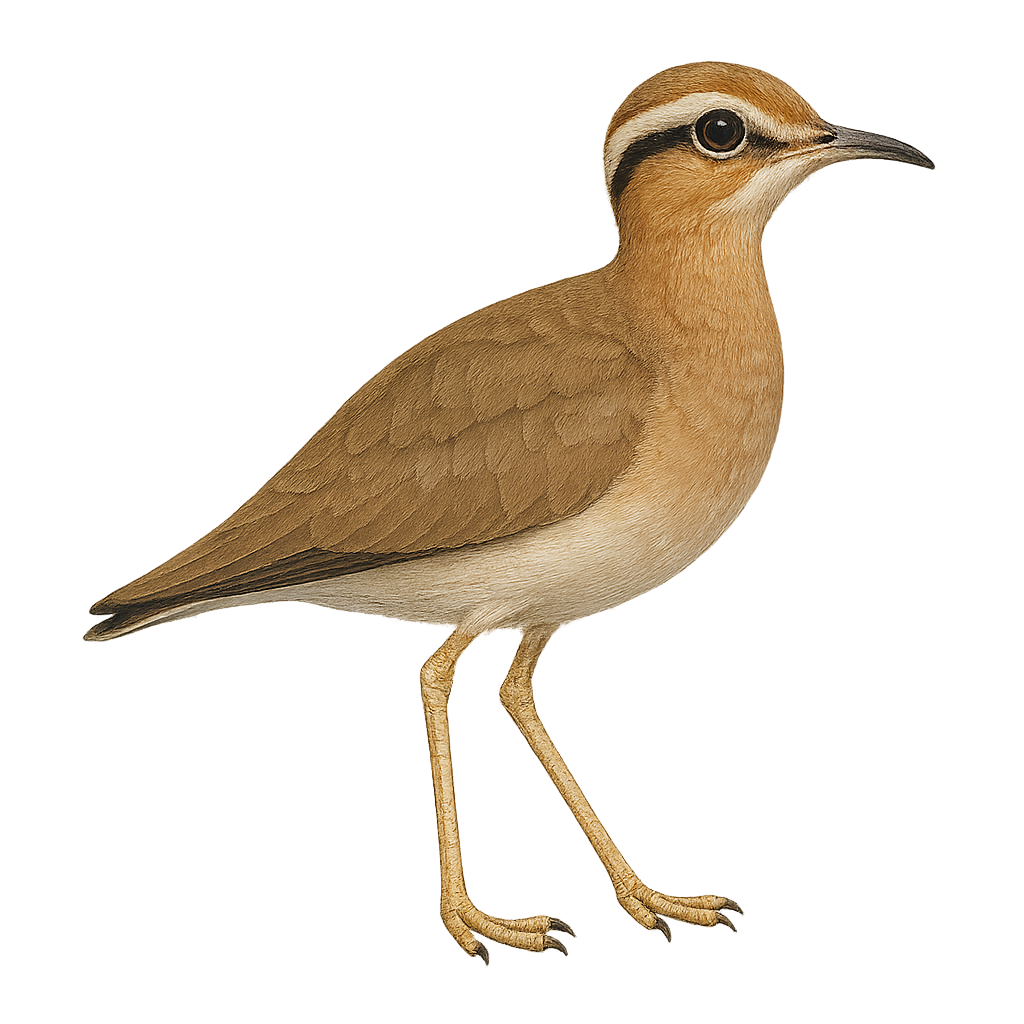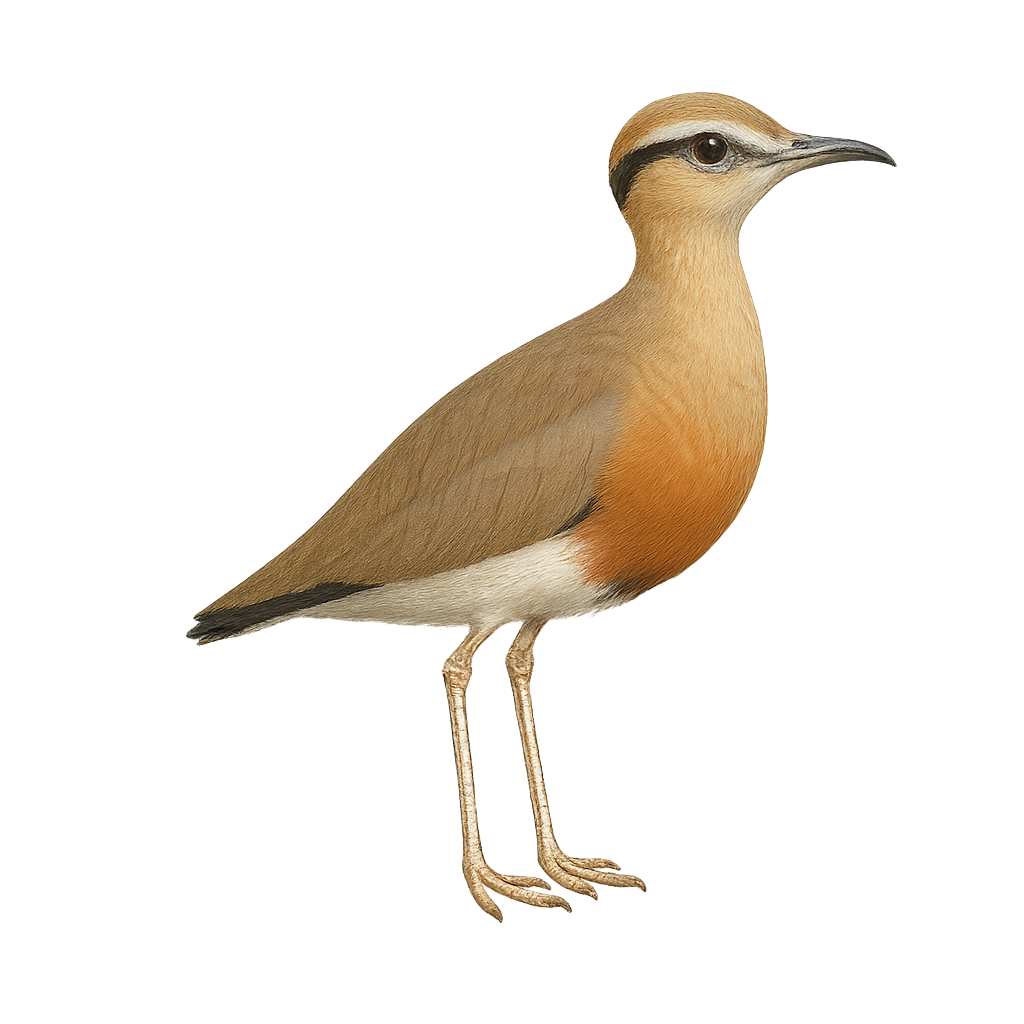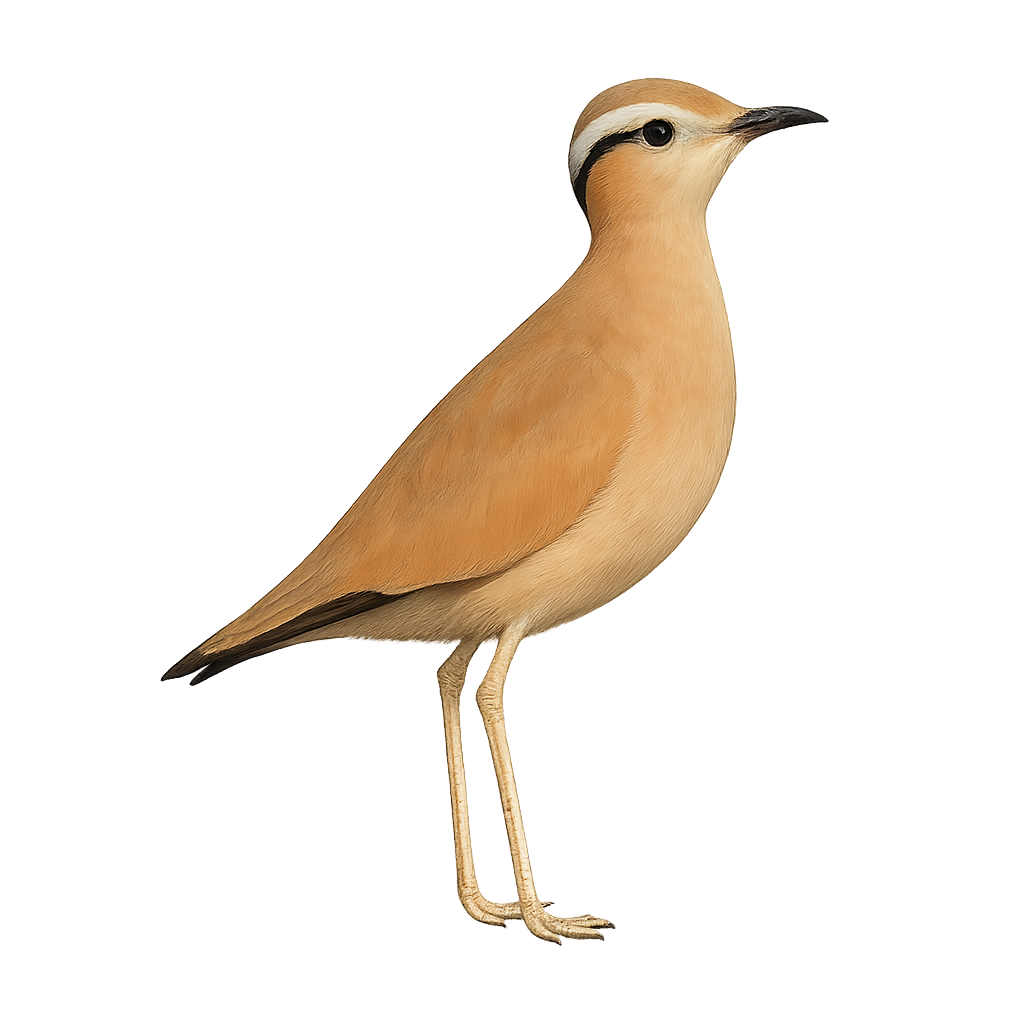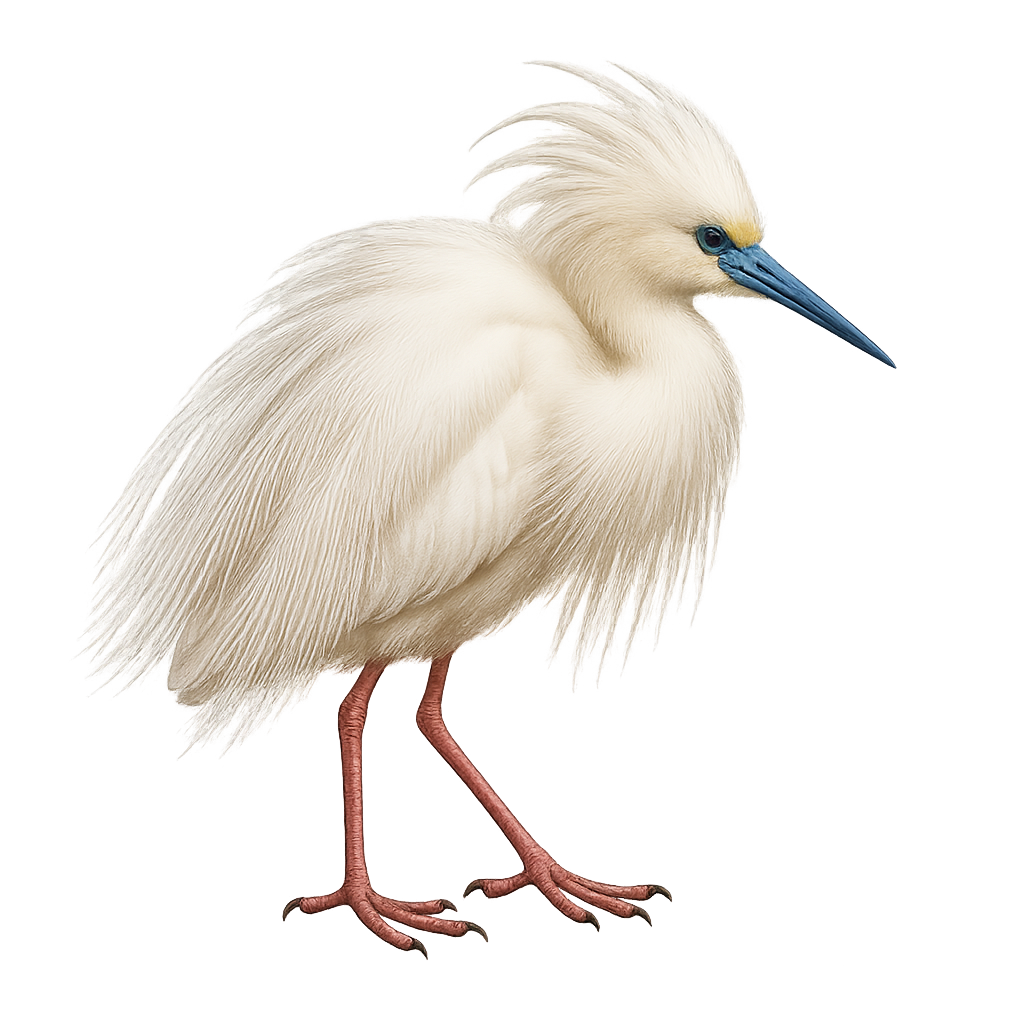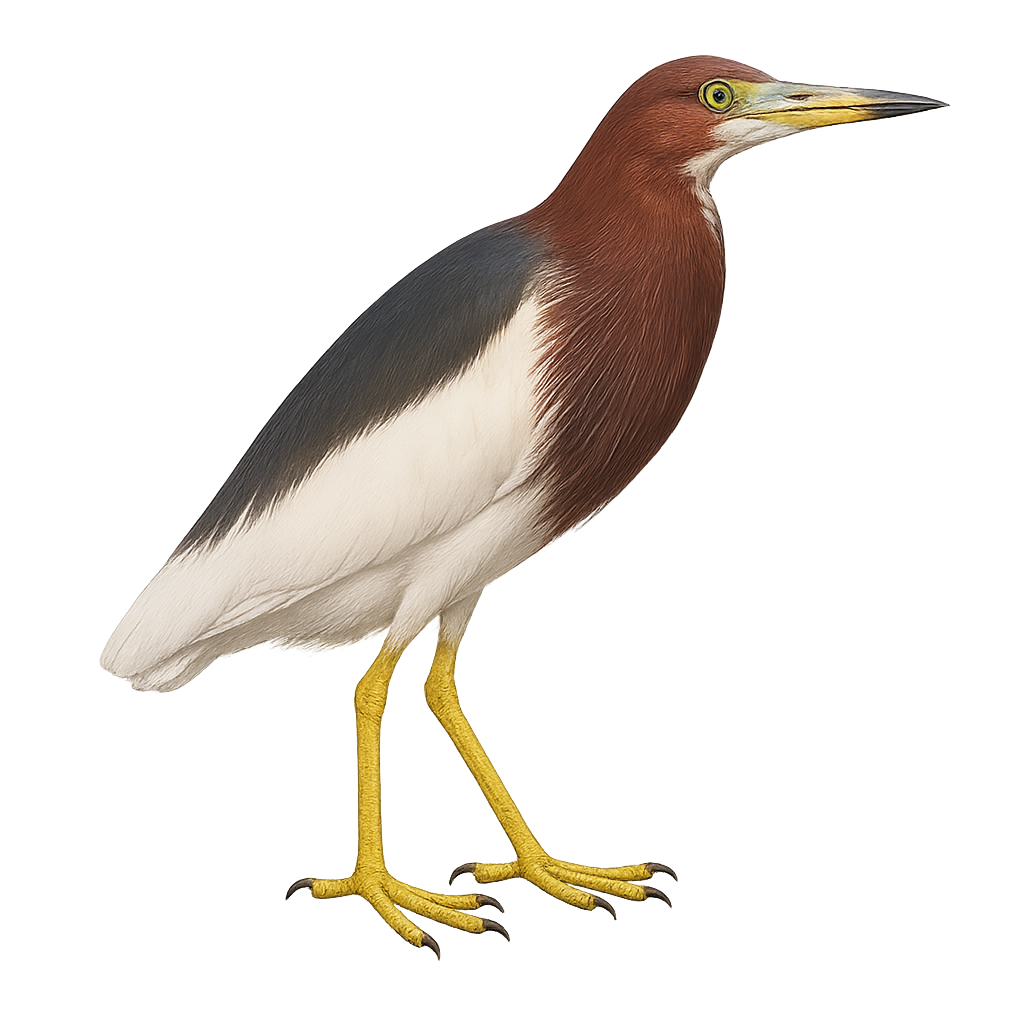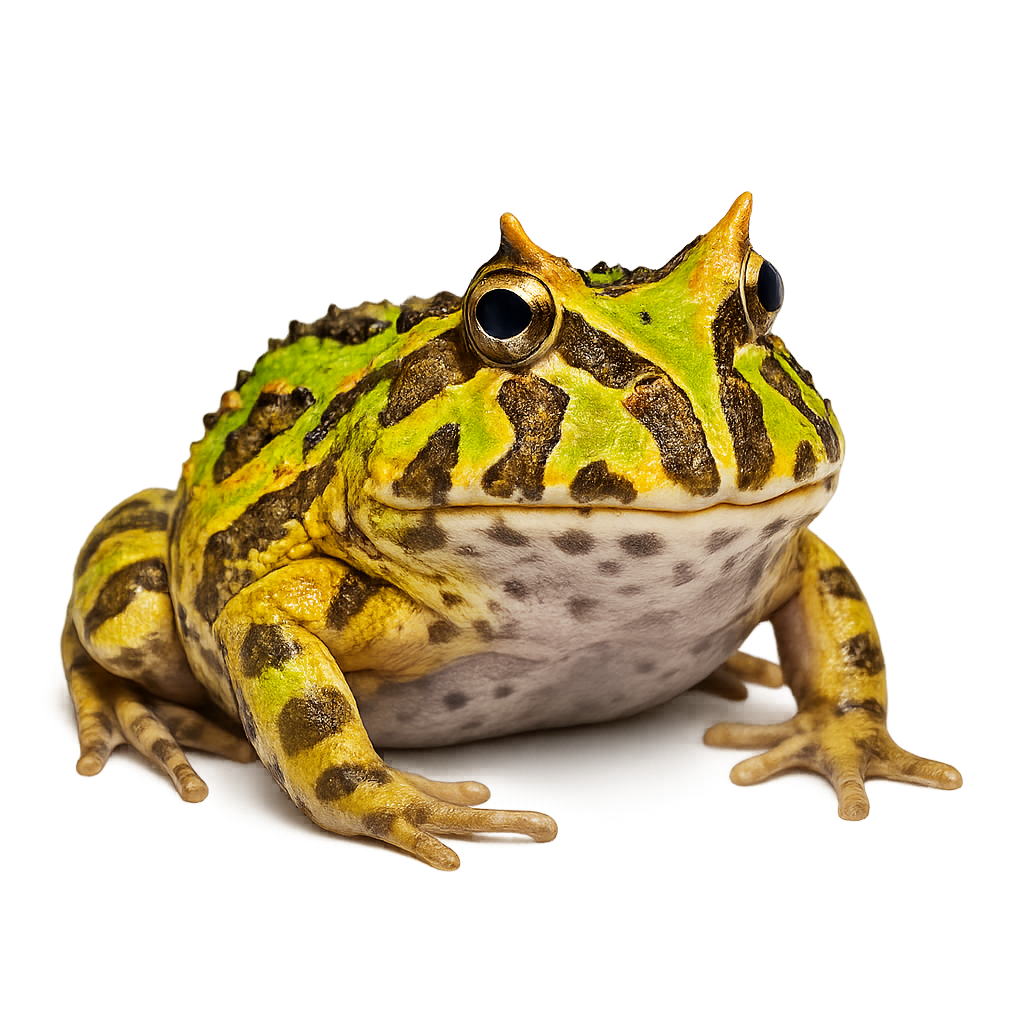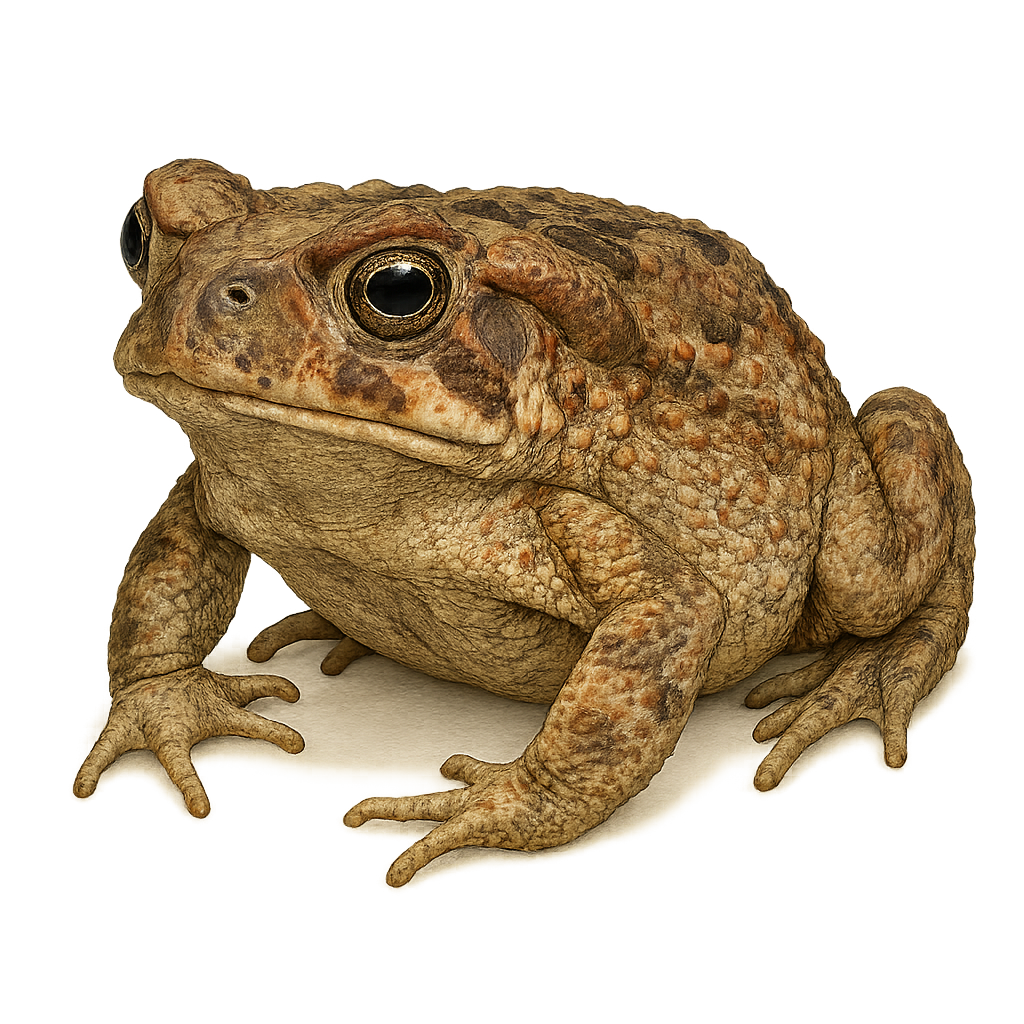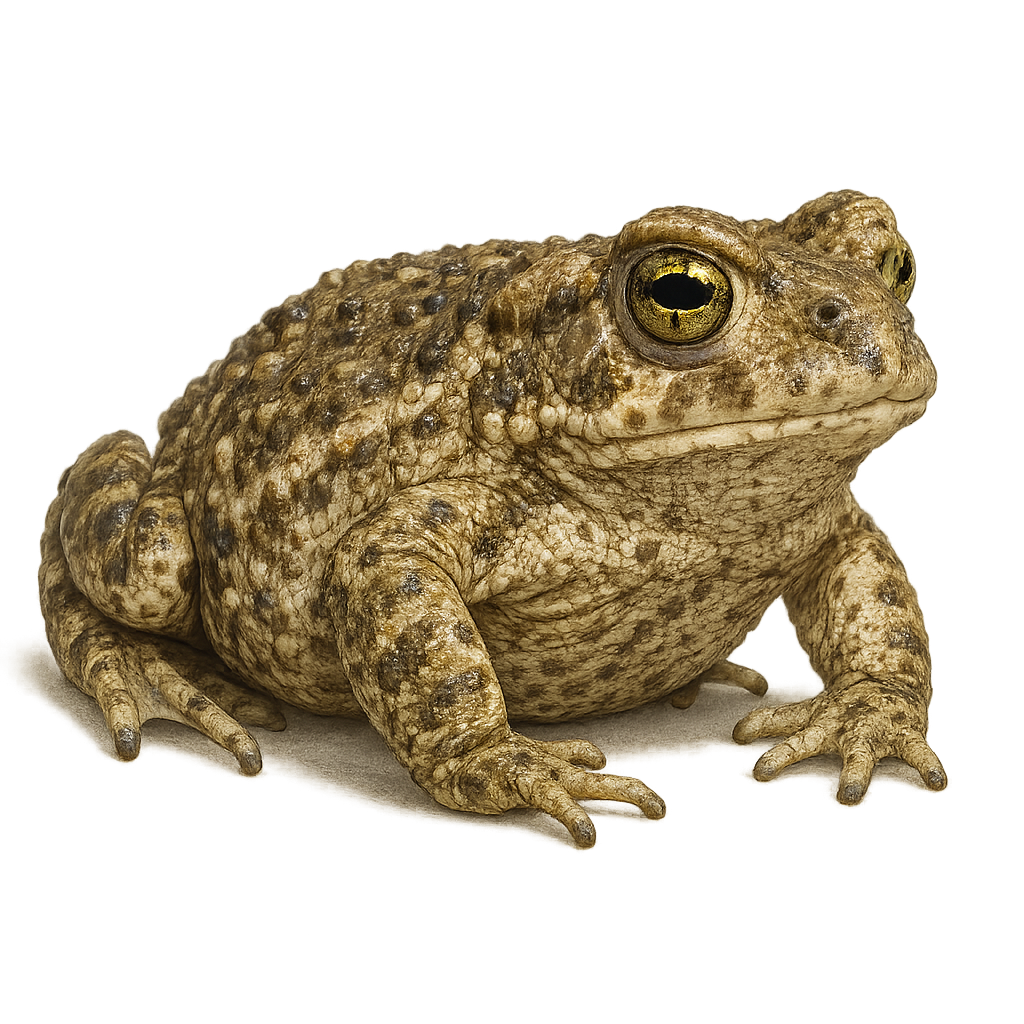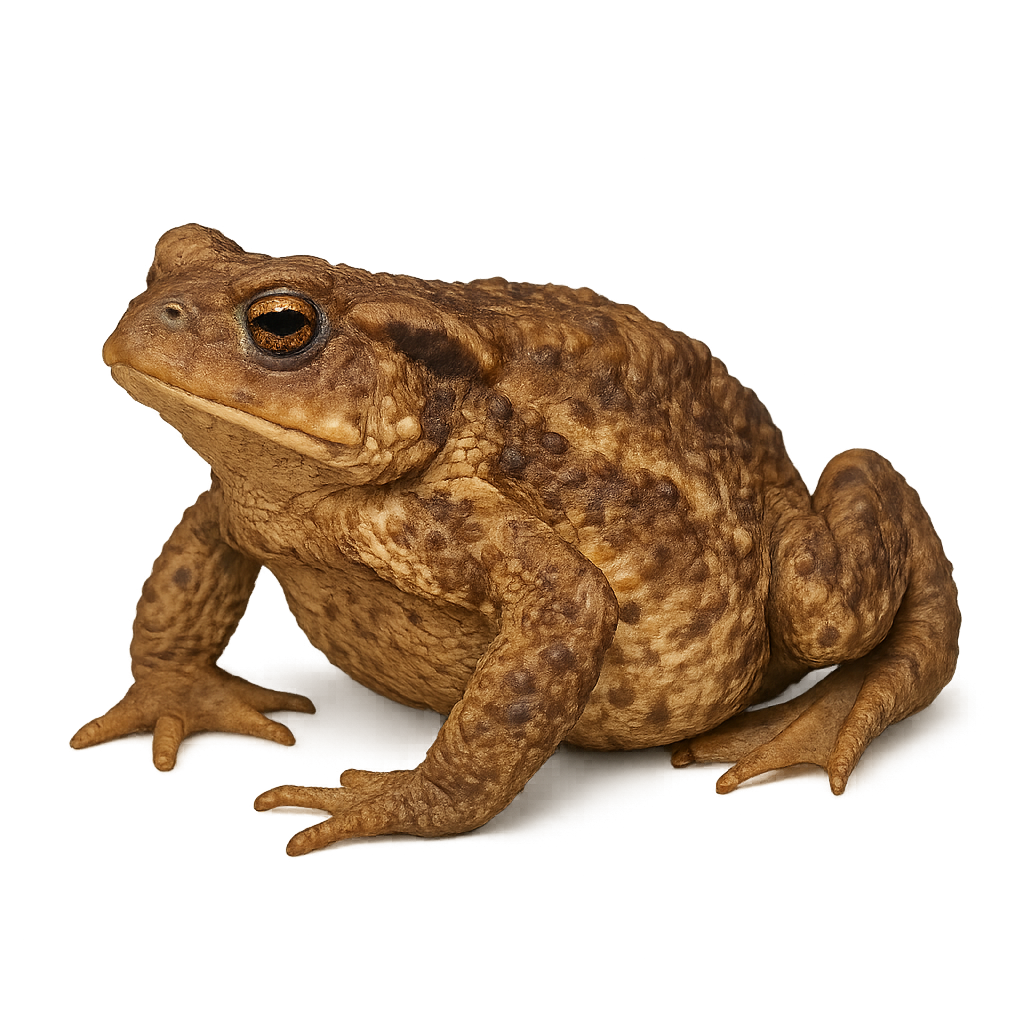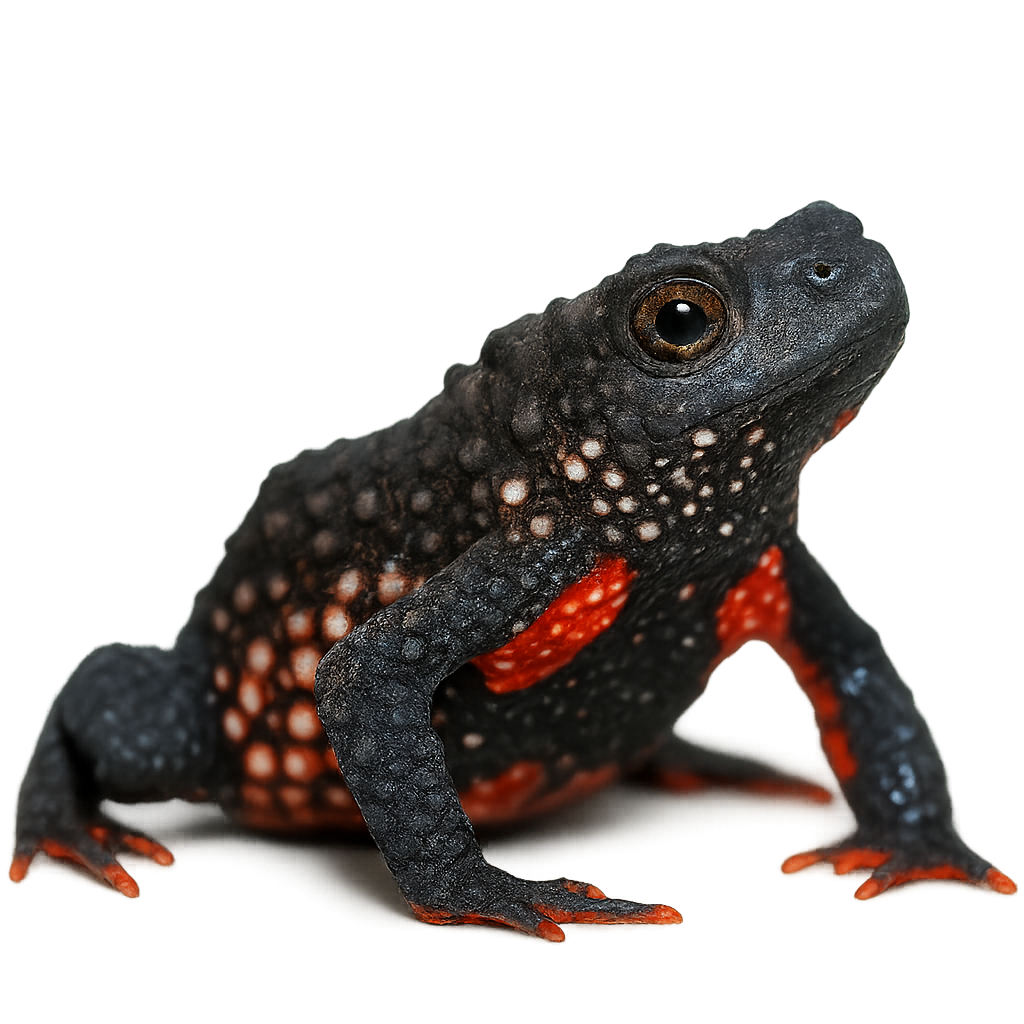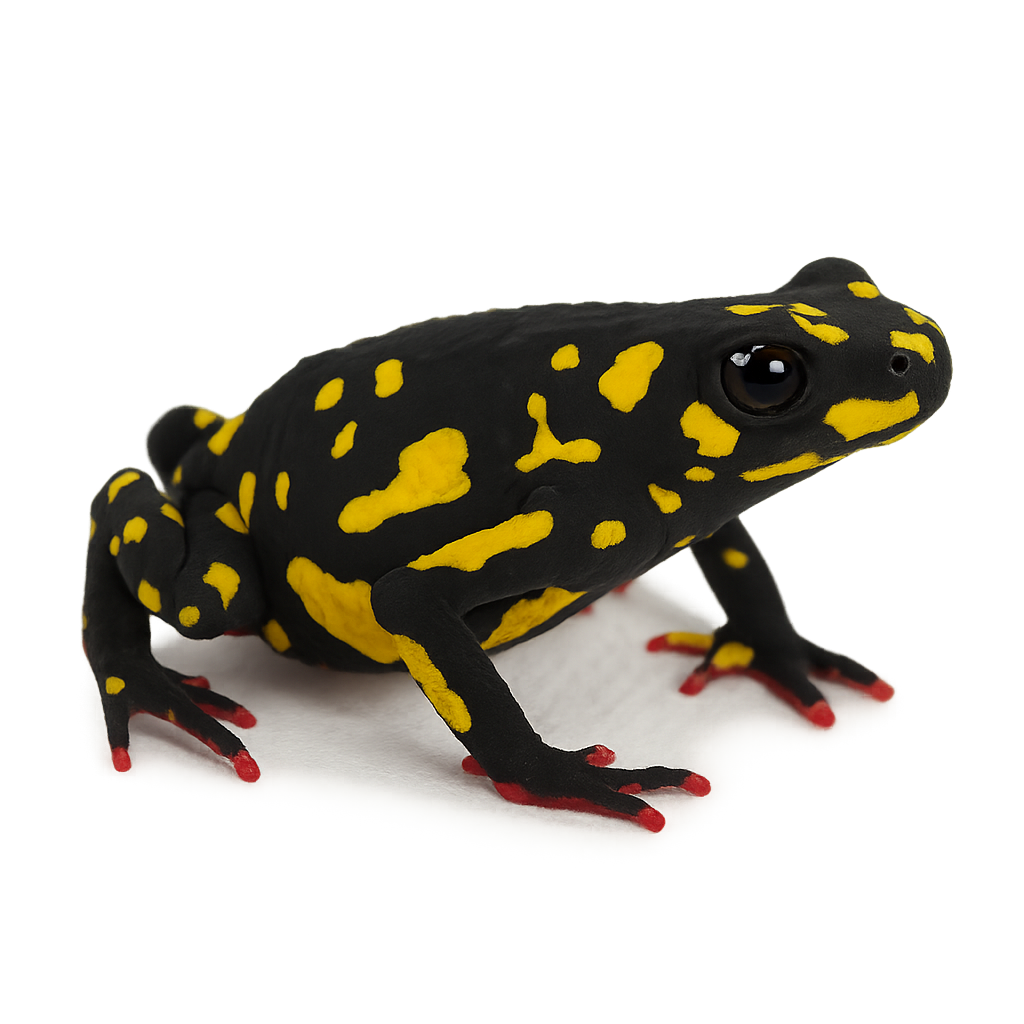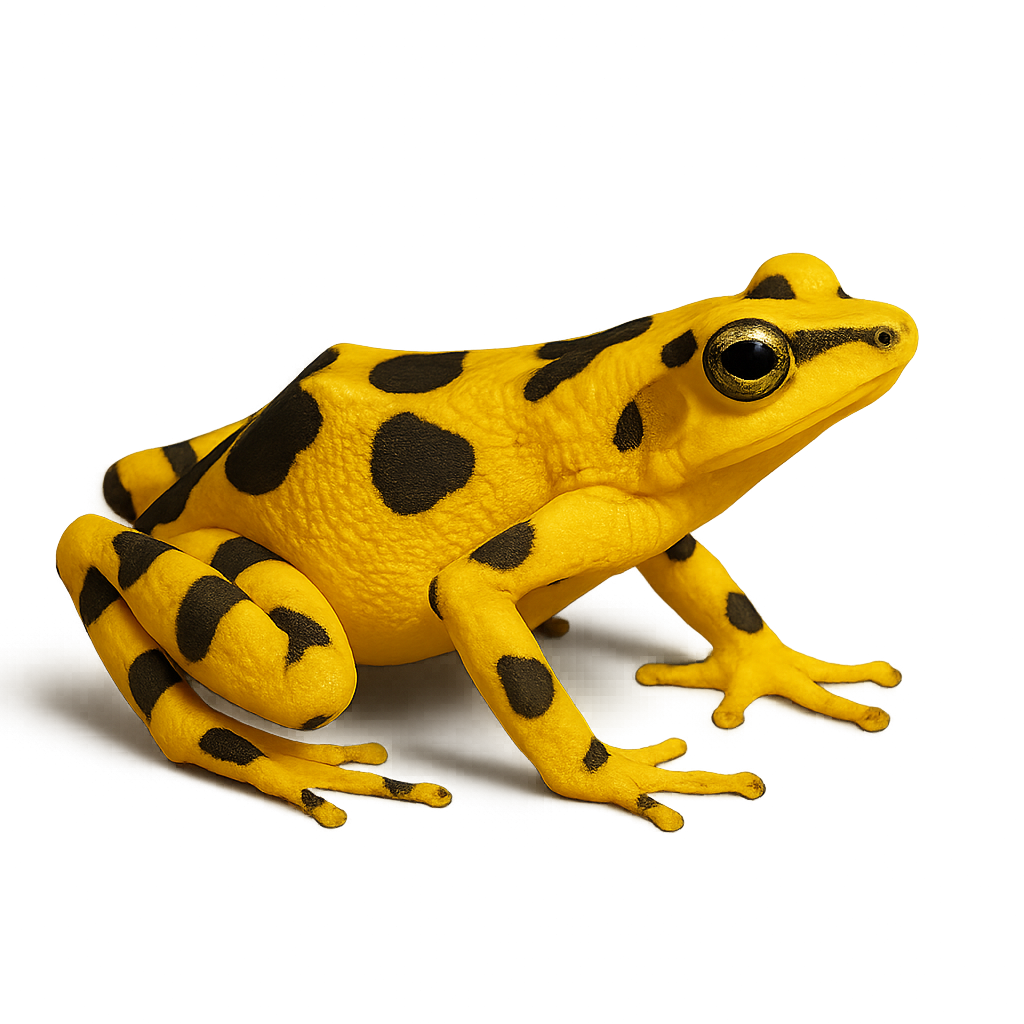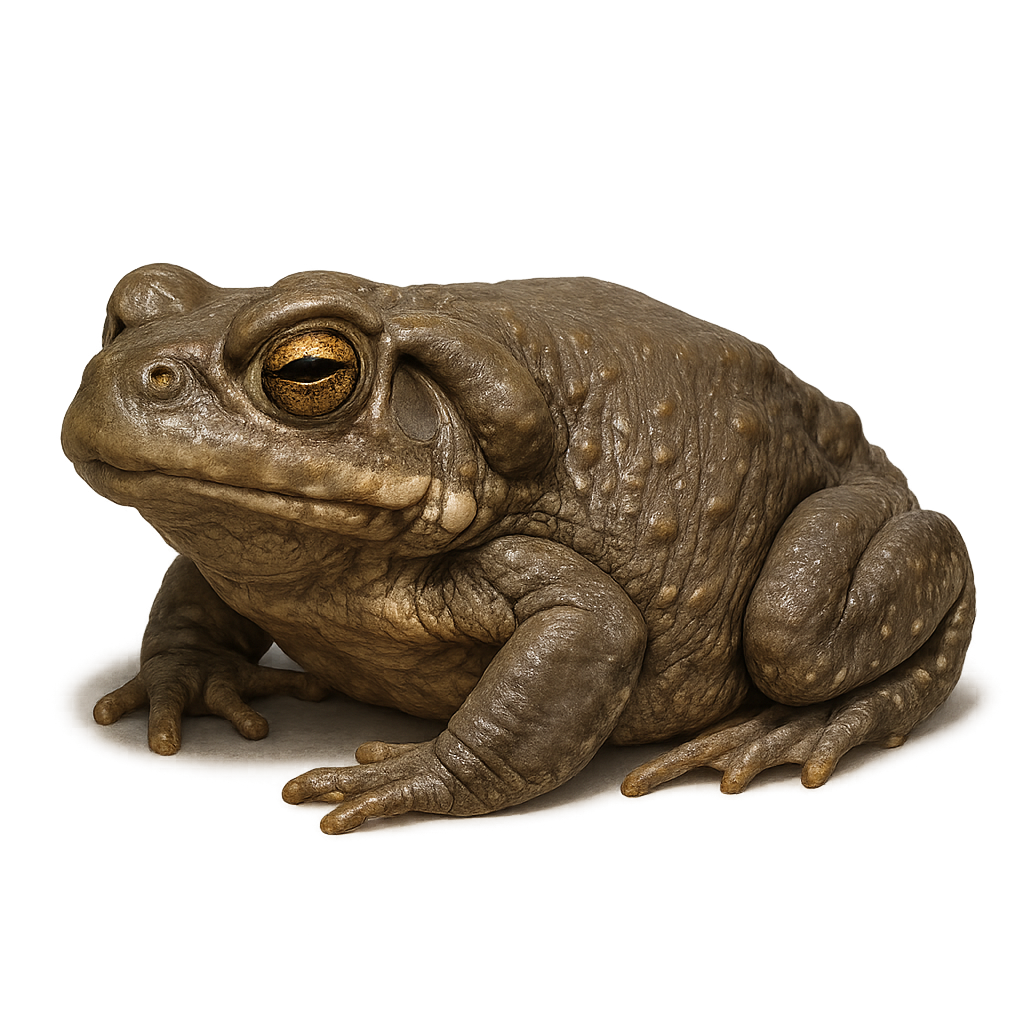The Leopard Snake, Zamenis situla, is a non-venomous snake known for its distinctive color pattern, featuring reddish-brown spots bordered with black on a gray or beige background. It is mainly found in southern Europe, particularly in Italy, Greece, and the Balkans. This snake prefers dry, rocky habitats, often near cultivated areas. Typically measuring between 60 and 90 cm, it is agile and feeds primarily on small mammals and birds. Although discreet and somewhat suspicious, it is not aggressive towards humans. Its conservation is concerning due to habitat loss and human persecution.
The dice snake, Natrix tessellata, is a medium-sized semi-aquatic snake, typically measuring between 70 and 100 cm. It has a slender body with a distinctive checkerboard pattern on its back, consisting of dark spots on a lighter background. Its coloration ranges from gray to brown, sometimes with greenish hues. It is often found near freshwater bodies, such as rivers and lakes, where it primarily feeds on fish and amphibians. Although non-venomous and harmless to humans, it can emit an unpleasant odor when threatened.
The Western Whip Snake is a slender snake that can reach up to 1.60 m in length. Its coloration is dark, black or dark green, speckled with yellow spots forming transverse bars at the front of the body and longitudinal lines towards the rear. The belly is light, yellow or greenish-white. Juveniles have a more uniform grayish to beige hue with distinctive head patterns. It inhabits dry and sunny environments, such as hedgerows, fallow lands, forest edges, and rocky areas, from plains up to 1900 m altitude. Diurnal and agile, it primarily feeds on small vertebrates: rodents, lizards, amphibians, and sometimes other snakes. Reproduction occurs in spring, with 5 to 15 eggs laid in June-July, incubated for 6 to 8 weeks. Protected species in Europe, it is vulnerable to habitat destruction and road traffic.
The Viperine snake is a non-venomous semi-aquatic snake, typically measuring between 50 and 90 cm, with a distinct head and round pupils. Its back features a dark zigzag pattern on a gray, brown, or greenish background, and its belly is yellow or reddish with black spots. It inhabits humid environments such as rivers, ponds, and lakes, where it primarily hunts fish, amphibians, and tadpoles. Reproduction occurs in spring, with 2 to 26 eggs laid in loose soil. This species is protected in Europe and is listed as Least Concern by the IUCN.
The Yellow-billed Cuckoo is a medium-sized migratory bird, measuring about 30 cm in length. It is easily recognizable by its distinctive yellow bill and long brown wings. Its plumage is primarily gray-brown on the top and white underneath, with white spots on the tail. This bird is often heard before it is seen, thanks to its characteristic call. It primarily inhabits deciduous forests and wooded areas near water. A migratory species, it winters in South America. Its diet mainly consists of insects, especially caterpillars, but it also consumes fruits.
The Limpkin, or Aramus guarauna, is a medium-sized wading bird easily identified by its brown plumage speckled with white and its long, slightly curved bill. It primarily inhabits marshes, lake edges, and rivers in Central and South America. This bird is often seen foraging for snails, its main food source, which it skillfully extracts from their shells using its specialized bill. The Limpkin is a solitary bird but can be seen in small groups during the breeding season. Its piercing, mournful call is often heard at dawn and dusk, adding a mysterious ambiance to marshy landscapes.
The Long-billed Curlew is a striking bird known for its long, downward-curving bill, perfect for probing the ground for food. It is the largest shorebird in North America, measuring between 50 and 65 cm in length. Its plumage is primarily brown with lighter patterns on the belly. It frequents open grasslands and wetlands, feeding mainly on insects, crustaceans, and small invertebrates. During the breeding season, it migrates to the central and western U.S. grasslands. The Long-billed Curlew is a protected species due to habitat loss.
The Eurasian Curlew is a large wader, easily recognizable by its long, down-curved bill and gray-brown plumage with dark speckling. This wader has a slender silhouette, long legs, and broad wings. It measures about 50 to 60 cm in length, with a wingspan of 90 to 105 cm. During the breeding season, the Eurasian Curlew has brighter and more contrasting plumage, but it becomes more subdued during winter, with duller tones.
The Eurasian Curlew primarily feeds on earthworms, invertebrates, and small crustaceans, which it captures in marshy areas, wet meadows, or along riverbanks. It is mainly observed in coastal areas or estuaries, where it forages by probing the ground for food. Although it is migratory, the Eurasian Curlew breeds mainly in Europe and winters in North Africa and southern Europe. It is currently classified as vulnerable due to habitat loss and disturbances in its breeding areas.
The Whimbrel is a medium-sized wader, easily recognized by its long, finely curved bill and its brown-gray plumage with lighter speckling on the belly. It measures about 40 to 50 cm in length and has a wingspan of about 70 to 85 cm. Unlike the Eurasian Curlew, it is more subtle in its behavior and colors, making it a bird that is often less visible despite its size.
This wader primarily inhabits coastal areas, estuaries, and mudflats, where it primarily feeds on small invertebrates, worms, and mollusks, which it captures from sandy or muddy soils at low tide. During migration, the Whimbrel can travel long distances, moving from its breeding grounds in Northern Europe to the coasts of West Africa. While it is considered a species of concern in some areas, it is primarily threatened by habitat loss and human disturbance.
The Far Eastern Curlew, or Numenius madagascariensis, is a large wader with a brownish plumage and a distinctive long, downward-curved bill. This unique bill is perfect for probing mudflats for food, mainly invertebrates. It frequents coastal wetlands and estuaries, often seen in small flocks. As a migratory bird, it travels long distances between its breeding grounds in Siberia and its wintering areas in Australia and Southeast Asia. Unfortunately, this species is threatened by habitat loss, primarily due to urbanization and agriculture. Conservation efforts are crucial to ensure its long-term survival.
The Cuckoo Roller, or Leptosomus discolor, is a unique and fascinating bird endemic to Madagascar and the Comoros. It is the sole member of the Leptosomidae family. This bird features distinctive plumage, with males displaying bluish-grey hues and females showing brown and mottled patterns. The Cuckoo Roller is known for its graceful gliding flight and resonant calls. It primarily inhabits tropical rainforests but can also be found in drier wooded areas. Its diet mainly consists of insects, small reptiles, and occasionally fruits. Although relatively common in its natural habitat, deforestation poses a potential threat to its population.
The Burchell's Courser, scientifically known as Cursorius rufus, is an elegant terrestrial bird primarily found in the arid and semi-arid regions of southern Africa. Its plumage is dominated by shades of beige and brown, allowing it to blend seamlessly into its sandy environment. The wings feature distinctive black and white markings visible in flight. This bird is known for its long legs and slender bill, adapted to its ground-dwelling lifestyle. It primarily feeds on insects and other small invertebrates, which it captures by running swiftly on the ground. The Burchell's Courser is a diurnal bird, often seen alone or in small groups. Its ability to camouflage and discreet behavior make it sometimes difficult to spot.
The Temminck's Courser, or Cursorius temminckii, is an elegant ground-dwelling bird primarily found in the arid and semi-arid regions of sub-Saharan Africa. It is distinguished by its sandy-brown plumage, long legs, and slender bill, adapted to its terrestrial lifestyle. This bird is often seen running swiftly on the ground in search of insects, its main food source. The Temminck's Courser is a diurnal bird, active mainly during the day. It is known for its ability to blend into its surroundings, making it difficult to spot. Although generally solitary, it can be seen in small groups during the breeding season.
The Cream-colored Courser, Cursorius cursor, is an elegant and swift terrestrial bird, primarily found in the arid and semi-arid regions of North Africa and the Middle East. Its slender silhouette, long legs, and light beige plumage with cream hues allow it to blend seamlessly into its desert surroundings. This bird is particularly adapted to desert life, feeding mainly on insects and small invertebrates. The Cream-colored Courser is known for its rapid running and ability to cover long distances in search of food. It typically nests on the ground in open areas, with its eggs well camouflaged among stones and sand.
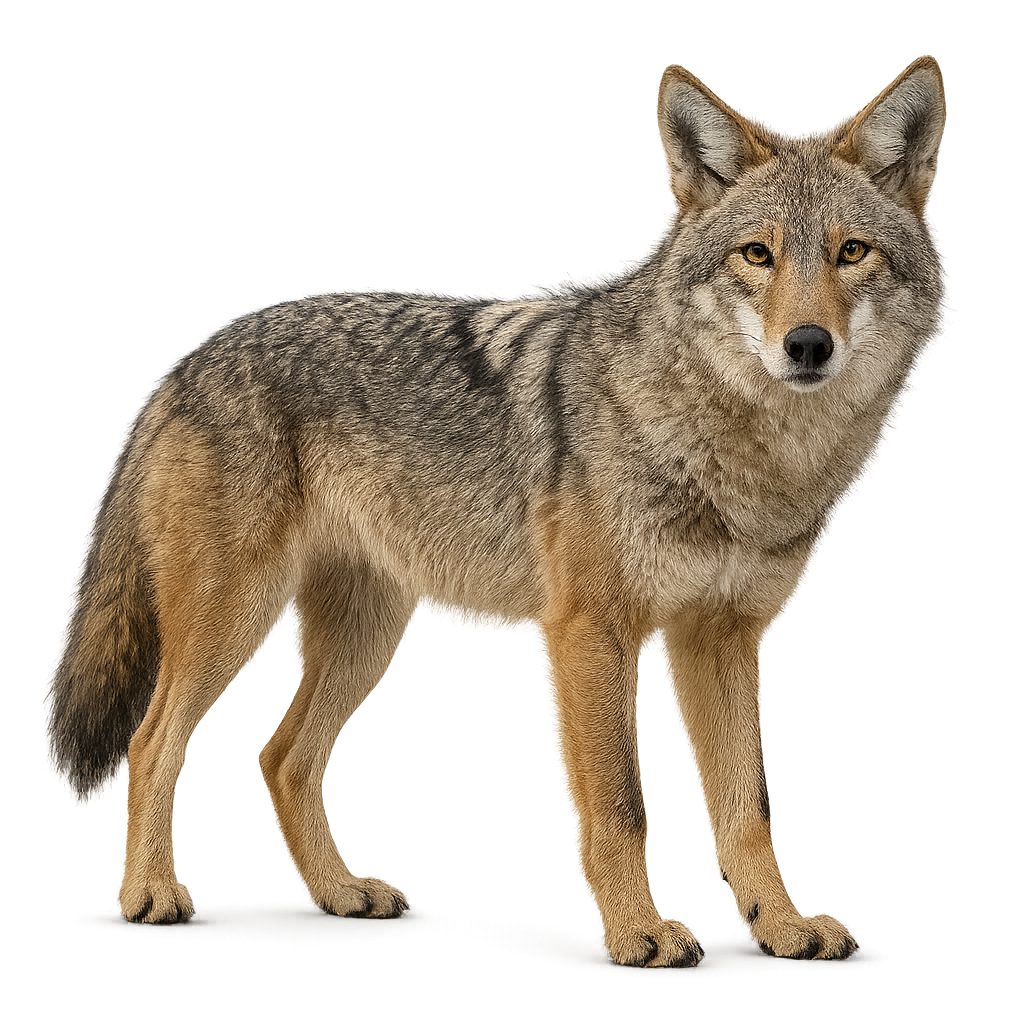
The Coyote is a medium-sized canine, very similar to the wolf but smaller and more agile. Its fur varies from gray to light brown, with a face often marked by black traits, a white chest and belly, and dark legs. The Coyote is easily recognizable by its pointed muzzle, relatively large ears, and bushy tail. It typically stands between 60 and 80 cm at the shoulder, with a total length of 75 to 90 cm for the body, excluding the tail.
This canine is an opportunistic feeder, primarily hunting small mammals such as rodents, rabbits, and sometimes birds, but it can also eat fruits and carrion. Highly adaptable, the Coyote inhabits a wide variety of environments, ranging from prairies and deserts to urban areas, and it is particularly active at dusk and during the night. Unlike other predators, the Coyote often hunts alone or in small groups. Although its population is stable across much of its range, it is sometimes seen as a nuisance in certain areas and faces threats from hunting and habitat loss.
The Madagascar Pond-Heron, Ardeola idae, is a medium-sized bird belonging to the Ardeidae family. It is primarily found in the wetlands of Madagascar, but also in some regions of East Africa. This bird is notable for its striking white breeding plumage, contrasting with its duller, brownish non-breeding plumage. It has a yellow bill and greenish legs. The Madagascar Pond-Heron feeds mainly on small fish, insects, and crustaceans, which it catches in shallow waters. It is often solitary or in small groups and typically breeds during the rainy season, building its nest in trees or shrubs near water.
The Squacco Heron is a small heron, easily recognizable by its head adorned with long white feathers that form a sort of mane, which gives it its name. Its plumage is primarily beige and white, with brown or gray shades on the wings and back, and a short, thick beak. This heron measures about 45 cm in length, with a wingspan of approximately 80 cm. It is often observed in wetland areas such as marshes, riverbanks, and ponds, where it primarily hunts small fish, aquatic insects, and crustaceans.
The Squacco Heron is a migratory bird found primarily in the Mediterranean regions, but its population is declining due to habitat loss and water pollution. Although it is a rather discreet and solitary bird, it can sometimes be seen in small groups during the breeding season. This heron has a characteristic hunting behavior, walking slowly in shallow water where it probes the ground with its beak.
The Chinese Pond Heron, Ardeola bacchus, is a small heron with distinctive plumage. During the breeding season, it displays vibrant colors with a reddish-brown head and neck, metallic green back, and white wings. Outside this period, it appears duller with brownish hues. Found mainly in Southeast Asia's wetlands, it inhabits rice fields, marshes, and lake edges, feeding on fish, insects, and small crustaceans. Its flight is swift and direct, often at low altitudes.
The Desert Horned Frog is an amphibian species found in the dry, sandy regions of South America, particularly in Argentina, Paraguay, and Uruguay. This toad is easily recognized by the large 'horns' above its eyes, giving it an imposing appearance. It is primarily terrestrial and often hides in the sand or under dead leaves to protect itself from the daytime heat. This frog is a voracious predator, using its large mouth to capture prey as large as small mammals or other amphibians. It is primarily nocturnal and waits until nightfall to hunt.
The cane toad (Rhinella marina) is a robust amphibian reaching up to 23 cm in total length, with a stocky body covered in rough, warty skin colored olive to deep brown. Native to tropical wetlands of Central and South America, it inhabits marshes, rice fields, slow-flowing streams and roadside ditches, preying on insects, spiders and small vertebrates. An invasive species introduced across multiple continents, it secretes potent skin toxins to deter predators. Males vocalize in resonant choruses during the rainy season. Breeding occurs in large communal pools, where females deposit thousands of eggs in gelatinous strings that hatch in two to five days. After hatching, tadpoles metamorphose rapidly and juveniles may live over ten years.
The natterjack toad, Epidalea calamita, is a medium-sized amphibian known for its warty skin and distinctive yellow dorsal stripe. It primarily inhabits sandy areas and heathlands in Western Europe. This toad is well adapted to dry environments and can travel long distances in search of water for breeding. Its call, a continuous trill, is often heard in spring. It feeds mainly on insects and other small invertebrates. Although its population is stable, it faces threats from habitat loss and pollution.
The common toad is a sturdy terrestrial amphibian of 8–13 cm with a warty olive-brown back and a yellowish spotted belly. It inhabits damp meadows, open woodland edges and gardens, feeding on insects, spiders and worms captured on the ground. During the breeding season, males emit a low, croaking call from the water’s surface to attract females, which lay strings of eggs in double rows.
The Melanophryniscus moreirae, or Maldonado Redbelly Toad, is a species of toad endemic to the mountainous regions of Brazil. This small amphibian, typically measuring between 2 and 3 cm, is notable for its rough skin and bright colors, often a mix of black, red, and yellow. These vivid colors serve as a warning signal to potential predators, as the Maldonado Redbelly Toad secretes potent skin toxins. It primarily inhabits high-altitude grasslands and cloud forests, where it feeds on insects and other small invertebrates. Although its habitat is limited, it plays a crucial role in the ecosystem by controlling insect populations.
Melanophryniscus stelzneri is a small, colorful toad native to South America, primarily found in Argentina and Brazil. Its skin is often black with red or yellow patterns, allowing it to blend into its natural environment. This toad is known for its unique defense behaviors, such as inflating its body to appear larger to predators. It prefers humid habitats like rainforests and wet grasslands, where it can hide under leaves and rocks. Although its population is stable, it is threatened by habitat loss due to agriculture and urbanization.
The golden poison dart frog is an iconic species of frog found in the humid tropical forests of Panama. It is famous for its vibrant golden-yellow color and is one of the most poisonous amphibians in the world. It primarily feeds on insects and small invertebrates found in its natural habitat. Unfortunately, this species is critically endangered due to habitat loss and diseases, and it is currently classified as endangered.
The Bufo alvarius, commonly known as the Colorado River Toad, is a fascinating species of toad found primarily in the arid regions of the southwestern United States and northern Mexico. This toad is particularly known for its large size, reaching up to 19 cm in length, and its smooth, moist skin, often speckled with dark spots. It is famous for the toxic secretions it produces, containing bufotenin, a psychoactive substance. These secretions are used by some predators as a means of defense. The Bufo alvarius is a nocturnal animal, preferring the cool hours of the night to hunt its prey, mainly insects and small invertebrates.
The Suriname Toad is a fascinating amphibian species, known for its unique appearance and extraordinary reproductive behavior. This flat and wide toad is often called the 'birthing toad' because of the way it carries its eggs on its back, where the tadpoles develop until they are ready to hatch. It primarily lives in slow-moving waters and swamps in the tropical forests of South America, particularly in Colombia, Venezuela, Suriname, and Guyana. Its flat body allows it to hide easily in aquatic substrate, and it is primarily nocturnal. Its skin is a brownish-green, and its appearance allows it to blend perfectly into its aquatic environment.
The Rhinella margaritifera, commonly known as the South American Common Toad, is a species of toad found primarily in the humid tropical forests of South America. This toad is distinguished by its rough skin and pearly patterns, which allow it to blend effectively into its natural environment. It is generally brown with darker spots, providing excellent protection against predators. The South American Common Toad is nocturnal, spending the day hidden under leaves or in burrows. It primarily feeds on insects and other small invertebrates. Although its habitat is threatened by deforestation, it is currently classified as of least concern by the IUCN.
The cane toad, or Bufo marinus, is a large amphibian native to Central and South America. It can grow up to 24 cm in length and weigh over 1 kg. Its skin is rough and covered with glands that secrete a potent toxin used for defense against predators. This nocturnal toad primarily feeds on insects but can also consume small animals. Introduced in several regions to control agricultural pests, it has become an invasive species, notably in Australia, where it has caused ecological imbalances. Its ability to adapt to various environments makes it a fascinating subject of study for biologists.
The Nanay Harlequin Toad, or Atelopus nanay, is a species of toad belonging to the Bufonidae family. Native to the humid tropical forests of Ecuador, this toad is known for its bright colors and smooth skin. It is often found near mountain streams and rivers, where it breeds. Unfortunately, this species is critically endangered due to habitat loss and chytridiomycosis, a fungal disease affecting amphibians. Conservation efforts are crucial to ensure its survival.


